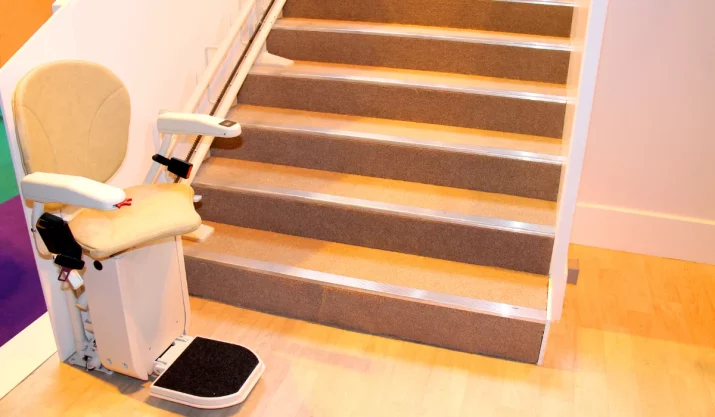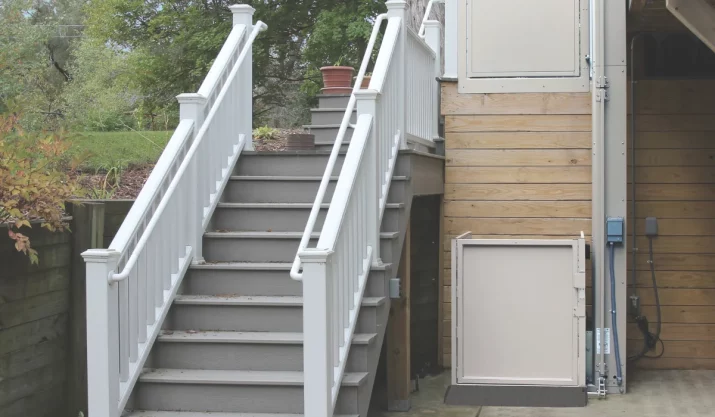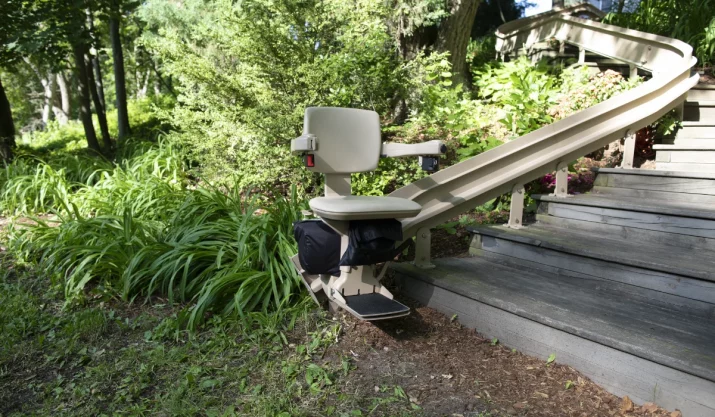Best Flooring Options for Homes with Stair Lifts

Table of Contents
- Key Takeaways
- Hardwood Floors: Strong and Smooth
- Low-Pile Carpet: Soft, but Not Too Soft
- Luxury Vinyl Plank (LVP): A Smart, Low-Hassle Choice
- Rubber Flooring: Safe and Slip-Resistant
- Composite Decking: Best for Outdoor Stair Lifts
- Tile Flooring: Good for Warm Climates, but Handle With Care
- Laminate Flooring: Looks Nice, but Not Always Strong Enough
- Make the Right Flooring Choice for Your Stair Lift
If you’re adding a stair lift to your home, your flooring choice matters more than you might think. It affects how safely and smoothly your stair lift runs. Whether you’re setting up straight stair lifts or curved ones, you’ll want a floor that supports the stair lift rail, reduces tripping hazards, and holds up to daily use.
This guide covers the best flooring options for homes with stair lifts, with clear advice on which materials work best and why. We’ll also look at how each option fits with different types of stair lifts and mobility needs.
Key Takeaways
- Flooring affects how safely and smoothly a stair lift works in homes with mobility issues or curved staircases.
- Hardwood, carpet, vinyl, and rubber are safe, durable options when paired with proper stair lift safety features.
- Tile, laminate, and composite need extra care or professional installation to support stair lifts without damage.
- California Mobility offers a free consultation to help you choose flooring that fits your specific stair lift needs.
Hardwood Floors: Strong and Smooth
Hardwood floors are a classic pick that works well with stair lifts. They offer a solid, flat surface that helps with stair lift installation, especially on straight staircases. If you have wood stairs with deep stair treads or rounded nosing, your installer may need to make adjustments so the stair lift rail and footrest don’t run into problems.
Woods like oak, maple, or hickory are all good choices because they’re durable. If you have pets or a lot of foot traffic, choose a high-quality matte finish to hide scratches.
Just keep in mind that hardwood can get slippery, so consider adding non-slip strips or textured nosing at the top of the stairs for extra grip.
Low-Pile Carpet: Soft, but Not Too Soft
For homes where comfort is important, low-pile carpet is a practical option. It cushions your steps and is easier on joints, which can help if you or a loved one has mobility issues. At the same time, it’s flat enough to avoid getting in the way of the footrest or swivel seat on chair lifts.
This type of carpet also helps in case of a power outage. If someone loses balance, the soft surface can reduce the risk of injury.
Just make sure to keep it clean, especially along curved staircases, where the stair lift travels closer to the floor and dirt can build up around the rail.
Luxury Vinyl Plank (LVP): A Smart, Low-Hassle Choice
Luxury vinyl plank is a great option for homes looking for something both cost-effective and durable. LVP looks like wood flooring, but it’s made from layers that resist water, scratches, and wear, perfect for busy households. It’s also thin and flat, making stair lift installation easier and more accurate.
If you’re doing a DIY remodel or adding a wheelchair lift along with your stair lift, LVP holds up well. It’s especially helpful for curved staircases, since the rail system needs a clean, level base across every turn.
Rubber Flooring: Safe and Slip-Resistant
Rubber flooring is one of the safest options if you’re focused on reducing fall risks.
It offers great traction and is soft underfoot, which helps in homes where mobility issues are a concern. It’s also easy to clean and works well when connecting outdoor stair lifts to indoor areas.
But rubber can compress over time, which may shift the stair lift rail slightly. That’s why it’s important to reinforce the area under the rail during installation.
If done right, it can provide both comfort and safety without sacrificing function.
Composite Decking: Best for Outdoor Stair Lifts
For outdoor stair lifts, like the kind that lead up to a porch or garden area, composite decking is a top option. It handles rain, sun, and changing temperatures without splitting or rotting. Compared to regular wood, it is less likely to cause slips or splinters.
Stair lift brands like Bruno offer models built for outdoor use.
Just make sure your installer checks the subfloor or base of the deck to make sure it can support the stair lift rail securely. This matters even more in places where the ground shifts or heats up quickly.
Tile Flooring: Good for Warm Climates, but Handle With Care
Tiles are common in California homes, especially where the weather stays warm. If you have tile stairs inside your home, stair lift installation is possible, but not always simple. Professional installers may need to drill screw holes into the tile, and if not done carefully, they can crack.
They are easy to clean and long-lasting, but they can be slippery. That makes them more important to add handrails and non-slip nosing near stair treads.
If you’re installing curved stairlifts or a stair lift on a spiral staircase, a professional installation is the safest way to go.
Laminate Flooring: Looks Nice, but Not Always Strong Enough
Laminate can seem like a good fit. It looks like wood and costs less. But it doesn’t always hold up under the weight and movement of stair lifts. Over time, the pressure from the rail or screw holes can cause the surface to wear out or shift, especially on curved staircases or a spiral staircase.
If you choose laminate, go with a thick, high-quality product. Make sure the subfloor is strong and level before starting any work. It might be fine for a short, straight staircase, but it isn’t the best match for more complex setups.
Choosing the right flooring depends on your home setup, mobility needs, and the type of stair lift you’re installing.
Here’s a quick comparison to help you weigh your options:
Flooring Comparison Table for Stair Lifts
| Flooring Type | Best For | Pros | Cons | Stair Lift Compatibility |
|---|---|---|---|---|
| Hardwood | Classic indoor stairs | Durable, smooth surface, easy installation | Slippery without added grip | Excellent for straight lifts |
| Low-Pile Carpet | Comfort and joint support | Soft, slip-resistant cushions fall | Needs regular cleaning near the rail | Good for all types |
| Luxury Vinyl Plank | Busy households, DIY remodels | Water/scratch-resistant, looks like wood, affordable | May dent under extreme weight | Ideal for curved or straight |
| Rubber Flooring | High-slip risk areas | Slip-resistant, soft, easy to clean | May compress over time under the rail | Great for indoor/outdoor use |
| Composite Decking | Outdoor stairs or porches | Weather-resistant, splinter-free, low-maintenance | Requires strong subfloor support | Built for outdoor lifts |
| Tile | Warm climates, easy cleaning | Durable, stylish, easy to sanitize | Slippery, prone to cracks during installation | Use with a professional install |
| Laminate | Budget-friendly look of wood | Low cost, wood-like appearance | Can shift or wear from screw pressure | Only for short, straight stairs |
Make the Right Flooring Choice for Your Stair Lift
The floor under your stair lift plays a bigger role than you might expect. From how well the rail is secured to how safely you can get on and off the lift, your flooring choice affects it all. Whether you’re installing a Bruno Elite straight stair lift for a loved one or choosing a model for your specific needs, the surface beneath your stairs matters.
Need help choosing the right floor for your stair lift installation?
At California Mobility, we’re here to walk you through the best choices based on your home, your staircase, and your safety needs. Schedule a free consultation with our team, and let’s build a safer, easier-to-navigate home, starting from the floor up.








